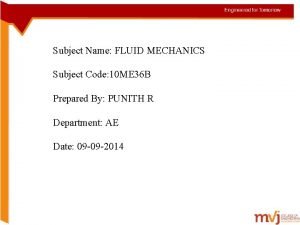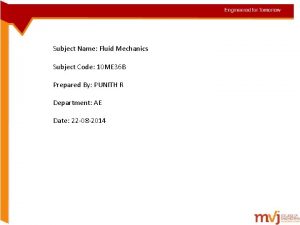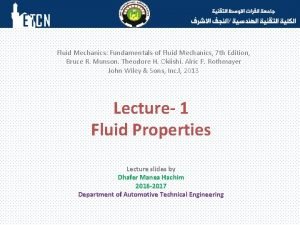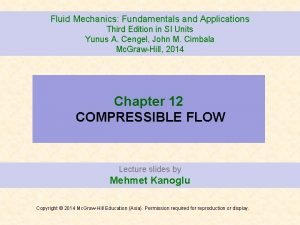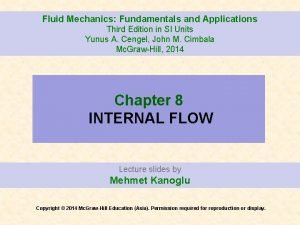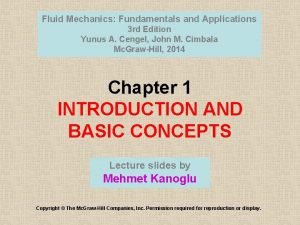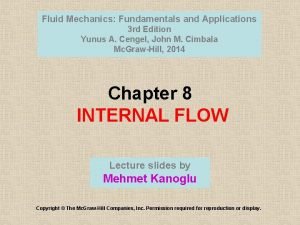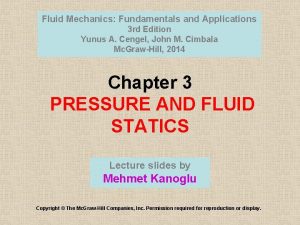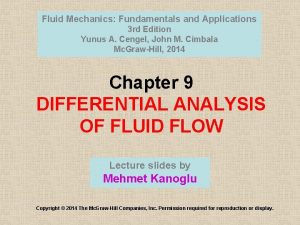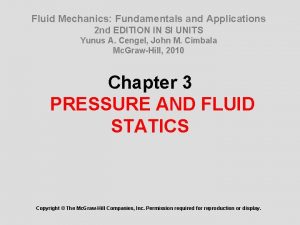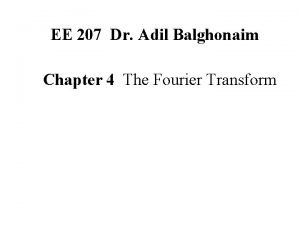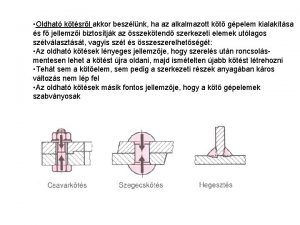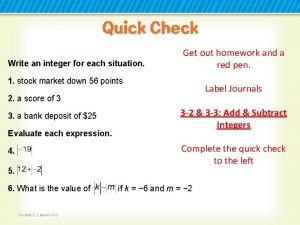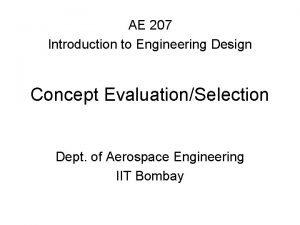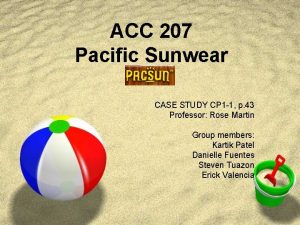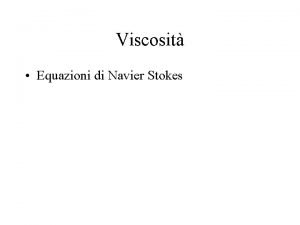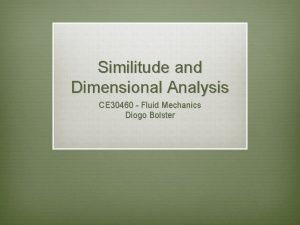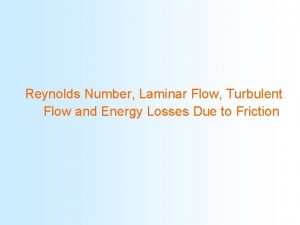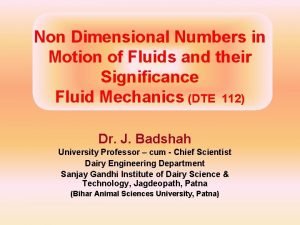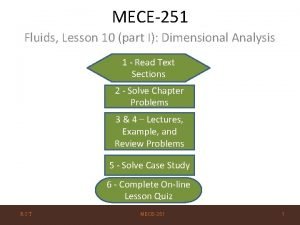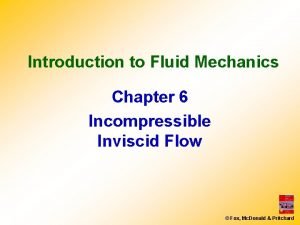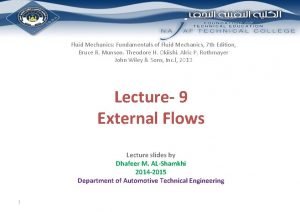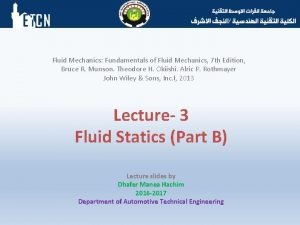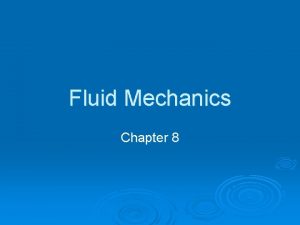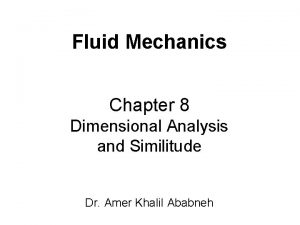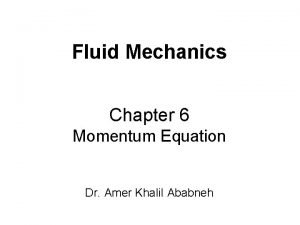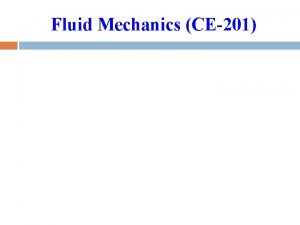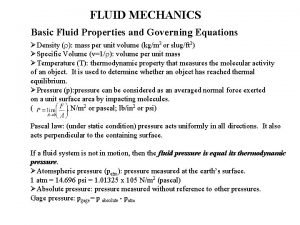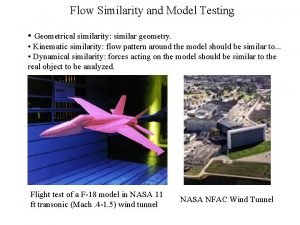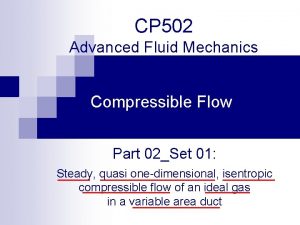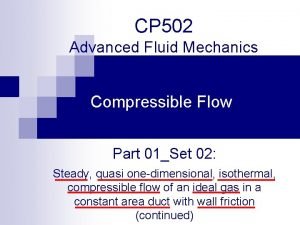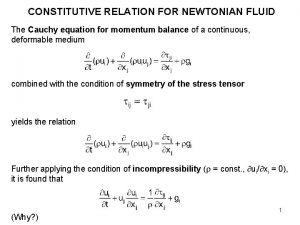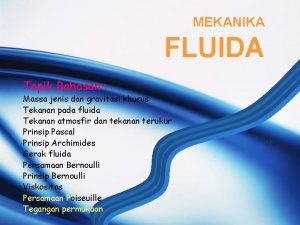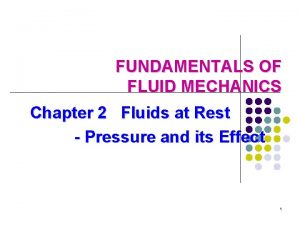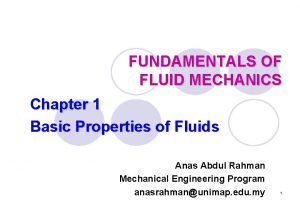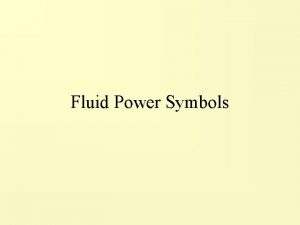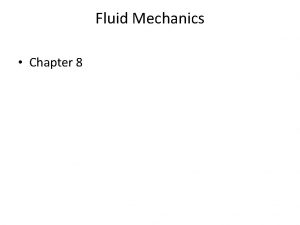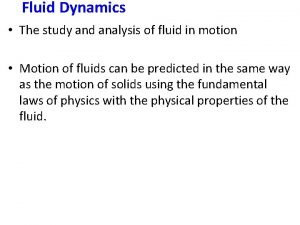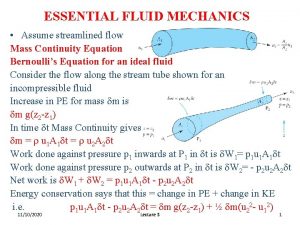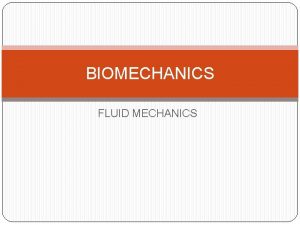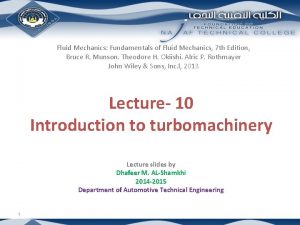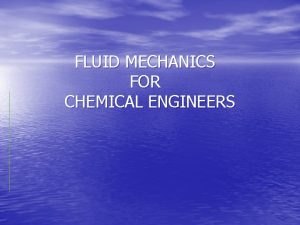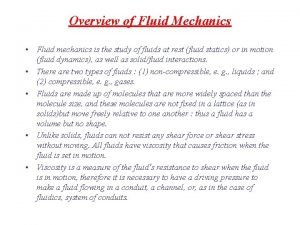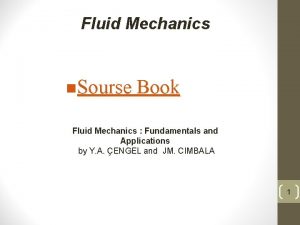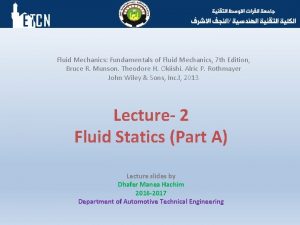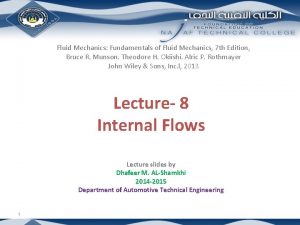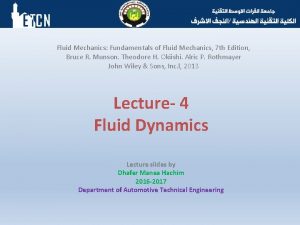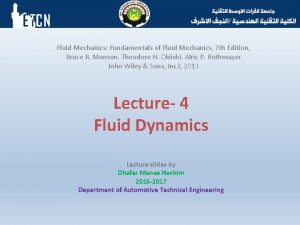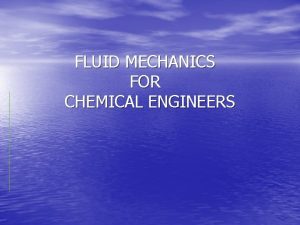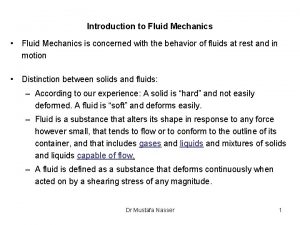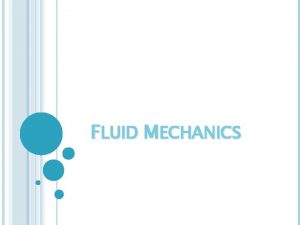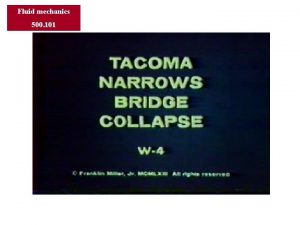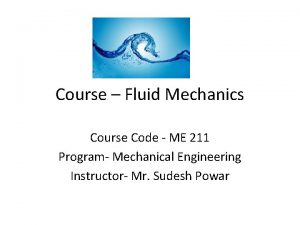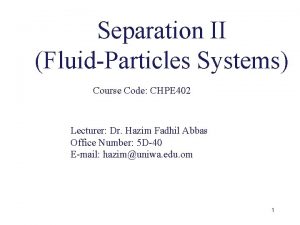Fluid Mechanics Course Code CHPE 207 and CIVL
































































- Slides: 64

Fluid Mechanics Course Code: CHPE 207 and CIVL 213 Lecturer: Dr Mustafa Saleh Nasser Office Number: 5 D-44 E-mail: mustafa. nasser@uniwa. edu. om Dr Mustafa Nasser 1

Dr Mustafa Nasser 2

Dr Mustafa Nasser 3

Dr Mustafa Nasser 4

Dr Mustafa Nasser 5

Dr Mustafa Nasser 6

Dr Mustafa Nasser 7

Dr Mustafa Nasser 8

Dimensions and Units In fluid mechanics we must describe various fluid characteristics in terms of certain basic quantities such as length, time and mass • A dimension is the measure by which a physical variable is expressed qualitatively, i. e. length is a dimension associated with distance, width, height, displacement. Ø Basic dimensions: Length, L (or primary quantities) Time, T Mass, M Temperature, Q Ø We can derive any secondary quantity from the primary quantities i. e. Force = (mass) x (acceleration) : F = M L T-2 • A unit is a particular way of attaching a number to the qualitative dimension: Systems of units can vary from country to country, but dimensions do not Dr Mustafa Nasser 9

Dr Mustafa Nasser 10

Units of Force – E system To make Newton’s law dimensionally consistent we must include a dimensional proportionality constant: where Dr Mustafa Nasser 11

1 2 Dr Mustafa Nasser 12

Dr Mustafa Nasser 13

3 Dr Mustafa Nasser 14

Density for Gasses – For gases: strong function of T and P from ideal gas law: r = P M/R T (can you drive this) where R = universal gas constant, M=mol. weight R= 8. 314 J/(g-mole K)=0. 08314 (liter bar)/(g-mole K)= 0. 08206 (liter atm)/(g-mole K)=1. 987 (cal)/(g-mole K)= 10. 73 (psia ft 3)/(lb-mole °R)=0. 7302 (atm ft 3)/(lb-mole °R) Dr Mustafa Nasser 15

Pressure is defined as the amount of force exerted on a unit area of a substance: P=F/A Pascal’s Laws Pascals’ laws: Pressure acts uniformly in all directions on a small volume (point) of a fluid In a fluid confined by solid boundaries, pressure acts perpendicular to the boundary – it is a normal force. Dr Mustafa Nasser 16

Direction of fluid pressure on boundaries Furnace duct Pipe or tube Heat exchanger Pressure is due to a Normal Force (acting perpendicular to the surface) It is also called a Surface Force Dam Dr Mustafa Nasser 17

Absolute and Gauge Pressure • Gauge pressure: Pressure expressed as the difference between the pressure of the fluid and that of the surrounding atmosphere. Dr Mustafa Nasser

Units for Pressure Unit Definition or Relationship 1 pascal (Pa) 1 kg m-1 s-2 1 bar 1 x 105 Pa 1 atmosphere (atm) 101, 325 Pa 1 torr 1 / 760 atm 760 mm Hg 1 atm 14. 696 pounds per sq. in. (psi) 1 atm Dr Mustafa Nasser 19

Pressure distribution for a fluid at rest We will determine the pressure distribution in a fluid at rest in which the only body force acting is due to gravity The sum of the forces acting on the fluid must equal zero Ø Consider an infinitesimal rectangular fluid element of dimensions Dx, Dy, Dz z y x Dr Mustafa Nasser 20

Pressure distribution for a fluid at rest Let Pz and Pz+Dz denote the pressures at the base and top of the cube, where the elevations are z and z+Dz respectively. -Force at base of cube: Pz A=Pz (Dx Dy) -Force at top of cube: Pz+Dz A= Pz+Dz (Dx Dy) -Force due to gravity: m g=r V g = r (Dx Dy Dz) g A force balance in the z direction gives: For an infinitesimal element (Dz 0) Fg Dr Mustafa Nasser 21

Variation of pressure with elevation

General variation of pressure in a static fluid due to gravity

General variation of pressure in a static fluid due to gravity for vertical direction: q = 0

Equality of pressure at the same level in a static fluid

Incompressible fluid Liquids are incompressible i. e. their density is assumed to be constant. When we have a liquid with a free surface the pressure P at any depth below the free surface is: where Po is the pressure at the free surface (Po=Patm) and h = zfree surface - z By using gauge pressures we can simply write: Dr Mustafa Nasser 26

Equality of pressure at the same level in a continuous fluid

Examples SG= 13. 6 Dr Mustafa Nasser 28

Solution: 1. 1 1. 2 Dr Mustafa Nasser 29

1. 3 Dr Mustafa Nasser 30

Calculate the weight of a reservoir of oil if it has a mass of 825 kg. We have

If the reservoir from previous Example has a volume of 0. 917 m 3, compute the density, the specific weight, and the specific gravity of the oil.

3. 7 Pressure expressed as the Height of a Column of Liquid • Then we can use this as a conversion factor,

Pressure Gages and Transducers • • • For those situations where only a visual indication is needed at the site where the pressure is being measured, a pressure gage is used. In other cases there is a need to measure pressure at one point and display the value at another. The general term for such a device is pressure transducer, meaning that the sensed pressure causes an electrical signal to be generated that can be transmitted to a remote location such as a central control station where it is displayed digitally.

Pressure Gages • Below Figs shows the Bourdon tube pressure gage.

Pressure Gages • • • The pressure to be measured is applied to the inside of a flattened tube, which is normally shaped as a segment of a circle or a spiral. The increased pressure inside the tube causes it to be straightened somewhat. The movement of the end of the tube is transmitted through a linkage that causes a pointer to rotate.

Pressure Gages • Figure below shows a pressure gage using an actuation means called Magnehelic pressure gage.

3. 8. 2 Strain Gage Pressure Transducer • • Fig 3. 17 shows the strain gage pressure transducer and indicator. The pressure to be measured is introduced through the pressure port and acts on a diaphragm to which foil strain gages are bonded. As the strain gages sense the deformation of the diaphragm, their resistance changes. The readout device is typically a digital voltmeter, calibrated in pressure units.

Strain Gage Pressure Transducer

LVST-Type Pressure Transducer • • A linear variable differential transformer (LVDT) is composed of a cylindrical electric coil with a movable rod-shaped core. As the core moves along the axis of the coil, a voltage change occurs in relation to the position of the core. This type of transducer is applied to pressure measurement by attaching the core rod to a flexible diaphragm. Fig shows the Linear variable differential transformer (LVDT)-type pressure transducer.

LVST-Type Pressure Transducer

Piezoelectric Pressure Transducer • • • Certain crystals, such as quartz and barium titanate, exhibit a piezoelectric effect, in which the electrical charge across the crystal varies with stress in the crystal. Causing a pressure to exert a force, either directly or indirectly, on the crystal leads to a voltage change related to the pressure change. Fig shows the digital pressure gage.

Piezoelectric Pressure Transducer

Buoyancy Archimedes Principle Laws of buoyancy discovered by Archimedes: – A body immersed in a fluid experiences a vertical buoyant force equal to the weight of the fluid it displaces – A floating body displaces its own weight in the fluid in which it floats F 1 h 1 Free liquid surface The upper surface of the body is subjected to a smaller force than the lower surface A net force is acting upwards H h 2 F 2 Dr Mustafa Nasser 44

Buoyancy The net force due to pressure in the vertical direction is: FB = F 2 - F 1 = (Pbottom - Ptop) (Dx. Dy) The pressure difference is: Pbottom – Ptop = r g (h 2 -h 1) = r g H FB = r g H (Dx. Dy) Thus the buoyant force is: FB = r g V where r = the fluid density If the fluid density is greater than the average density of the object, the object floats. If less, the object sinks Dr Mustafa Nasser 45

Example Consider a solid cube of dimensions 1 ft x 1 ft (=0. 305 m x 0. 305 m). Its top surface is 10 ft (=3. 05 m) below the surface of the water. The density of water is rf=1000 kg/m 3. Consider two cases: a) The cube is made of cork (r. B=160. 2 kg/m 3) b) The cube is made of steel (r. B=7849 kg/m 3) In what direction does the body tend to move? Dr Mustafa Nasser 46

Dr Mustafa Nasser 47

Shear in Different Fluids • Shear-stress relations for different types of fluids • Newtonian fluids: linear relationship • Slope of line (coefficient of proportionality) is “viscosity”

Dr Mustafa Nasser 49

Viscosity v The constant of proportionality is designated by the Greek symbol (mu) and is called the absolute viscosity, dynamic viscosity, or simply the viscosity of the fluid. v The viscosity depends on the particular fluid, and for a particular fluid the viscosity is also dependent on temperature.

Viscosity and Temperature 1/3 v For fluids, the viscosity decreases with an increase in temperature. v For gases, an increase in temperature causes an increase in viscosity. ð WHY? molecular structure.

Fluid Properties Example 1 Explain why the viscosity of a liquid decreases while that of a gas increases with a temperature rise. The following is a table of measurement for a fluid at constant temperature. Determine the dynamic viscosity of the fluid. du/dy (rad s-1) t (N m-2) 0. 00 0. 20 0. 01 0. 40 1. 90 0. 60 3. 10 Dr Mustafa Nasser 0. 80 4. 00 52

Using Newton's law of viscocity where m is the viscosity. So viscosity is the gradient of a graph of shear stress against vellocity gradient of the above data, or Plot the data as a graph: Calculate the gradient for each section of the line du/dy (s-1) 0. 0 0. 2 0. 4 0. 6 0. 8 t (N m-2) 0. 0 1. 9 3. 1 4. 0 Gradient - 5. 0 4. 75 5. 17 5. 0 Thus the mean gradient = viscosity = 4. 98 N s / m 2 Dr Mustafa Nasser 53

Example 2: 5. 6 m 3 of oil weighs 46 800 N. Find its mass density, and relative density. Solution 2: Weight 46 800 = mg Mass m = 46 800 / 9. 81 = 4770. 6 kg Mass density r = Mass / volume = 4770. 6 / 5. 6 = 852 kg/m 3 Relative density Dr Mustafa Nasser 54

Example 3 The velocity distribution of a viscous liquid (dynamic viscosity m = 0. 9 Ns/m 2) flowing over a fixed plate is given by u = 0. 68 y - y 2 (u is velocity in m/s and y is the distance from the plate in m). What are the shear stresses at the plate surface and at y=0. 34 m? Dr Mustafa Nasser 55

At the plate face y = 0 m, Calculate the shear stress at the plate face At y = 0. 34 m, As the velocity gradient is zero at y=0. 34 then the shear stress must also be zero. Dr Mustafa Nasser 56

Example 4 In a fluid the velocity measured at a distance of 75 mm from the boundary is 1. 125 m/s. The fluid has absolute viscosity 0. 048 Pa s and relative density 0. 913. What is the velocity gradient and shear stress at the boundary assuming a linear velocity distribution. m = 0. 048 Pa s g = 0. 913 Dr Mustafa Nasser 57

Newtonian and Non-Newtonian Fluid v Fluids for which the shearing stress is linearly related to the rate of shearing strain are designated as Newtonian fluids v Most common fluids such as water, air, and gasoline are Newtonian fluid under normal conditions. v Fluids for which the shearing stress is not linearly related to the rate of shearing strain are designated as non-Newtonian fluids.

Non-Newtonian Fluids

Non-Newtonian Fluids Newtonian Fluid Non-Newtonian Fluid η is the apparent viscosity and is not constant for non-Newtonian fluids.

η - Apparent Viscosity The shear rate dependence of η categorizes non-Newtonian fluids into several types. Power Law Fluids: Ø Pseudoplastic – η (viscosity) decreases as shear rate increases (shear rate thinning) Ø Dilatant – η (viscosity) increases as shear rate increases (shear rate thickening) Bingham Plastics: Ø η depends on a critical shear stress (t 0) and then becomes constant

Non-Newtonian Fluids Bingham Plastic: sludge, paint, blood, ketchup Pseudoplastic: latex, paper pulp, clay solns. Newtonian Dilatant: quicksand

non-Newtonian Fluids 1/2 v Shear thinning fluids: The viscosity decreases with increasing shear rate – the harder the fluid is sheared, the less viscous it becomes. Many colloidal suspensions and polymer solutions are shear thinning. Latex paint is example.

non-Newtonian Fluids 2/2 v. Shear thickening fluids: The viscosity increases with increasing shear rate – the harder the fluid is sheared, the more viscous it becomes. Water-corn starch mixture watersand mixture are examples. Bingham plastic: neither a fluid nor a solid. Such material can withstand a finite shear stress without motion, but once the yield stress is exceeded it flows like a fluid. Toothpaste and mayonnaise are common examples.
 Civl
Civl Define fluid kinematics
Define fluid kinematics Loss of head due to sudden contraction of pipe *
Loss of head due to sudden contraction of pipe * Elevation head formula
Elevation head formula Fluid compartments in the body
Fluid compartments in the body Movement of body fluids
Movement of body fluids Fluid mechanics fundamentals and applications 3rd edition
Fluid mechanics fundamentals and applications 3rd edition Micro and nanoscale fluid mechanics
Micro and nanoscale fluid mechanics Fluid mechanics fundamentals and applications
Fluid mechanics fundamentals and applications Mach number in fluid mechanics
Mach number in fluid mechanics Hydraulic diameter
Hydraulic diameter Fluid mechanics fundamentals and applications
Fluid mechanics fundamentals and applications Fluid mechanics fundamentals and applications
Fluid mechanics fundamentals and applications Fluid mechanics fundamentals and applications
Fluid mechanics fundamentals and applications Viscous fluid example
Viscous fluid example Fluid mechanics fundamentals and applications
Fluid mechanics fundamentals and applications European fluid mechanics and turbulence conference
European fluid mechanics and turbulence conference Iso/tc 207
Iso/tc 207 Art 207 tfeu
Art 207 tfeu Adil balghonaim
Adil balghonaim Msz 207
Msz 207 How to write an integer for each situation
How to write an integer for each situation As a result of 207 years of pax romana, the roman empire
As a result of 207 years of pax romana, the roman empire Pg 207
Pg 207 Oae 207
Oae 207 Apche web server
Apche web server Csc 207
Csc 207 Oecd 207
Oecd 207 Ae 207
Ae 207 Acc 207
Acc 207 Code commit code build code deploy
Code commit code build code deploy Is synovial fluid extracellular fluid
Is synovial fluid extracellular fluid Fluid statics deals with fluid at rest
Fluid statics deals with fluid at rest Fluid statics deals with
Fluid statics deals with Intracellular extracellular fluid
Intracellular extracellular fluid Interstitial vs intracellular
Interstitial vs intracellular Shifting dullness positive
Shifting dullness positive Equazioni navier stokes
Equazioni navier stokes Dimensional analysis fluid mechanics
Dimensional analysis fluid mechanics Hazen and williams formula
Hazen and williams formula Fluid mechanics pdhpe
Fluid mechanics pdhpe Dimensionless numbers in fluid mechanics
Dimensionless numbers in fluid mechanics Dimensionless groups in fluid mechanics
Dimensionless groups in fluid mechanics Incompressible inviscid flow
Incompressible inviscid flow Critical flow
Critical flow What is reynolds number in fluid mechanics
What is reynolds number in fluid mechanics Center of pressure equation
Center of pressure equation Chapter 8 fluid mechanics
Chapter 8 fluid mechanics Similitude fluid mechanics
Similitude fluid mechanics Momentum equation fluid mechanics examples
Momentum equation fluid mechanics examples Viscosity unit
Viscosity unit Fluid mechanics
Fluid mechanics Dimensionless groups in fluid mechanics
Dimensionless groups in fluid mechanics What is euler equation
What is euler equation Cp fluid mechanics
Cp fluid mechanics Cp fluid mechanics
Cp fluid mechanics Constitutive equation in fluid mechanics
Constitutive equation in fluid mechanics Fluid mechanics topics
Fluid mechanics topics Multifluid manometer example
Multifluid manometer example Specific weight symbol
Specific weight symbol Fluid mechanics 101
Fluid mechanics 101 Symbol
Symbol Mass density in fluid mechanics
Mass density in fluid mechanics What is discharge fluid mechanics
What is discharge fluid mechanics What is continuity equation
What is continuity equation


